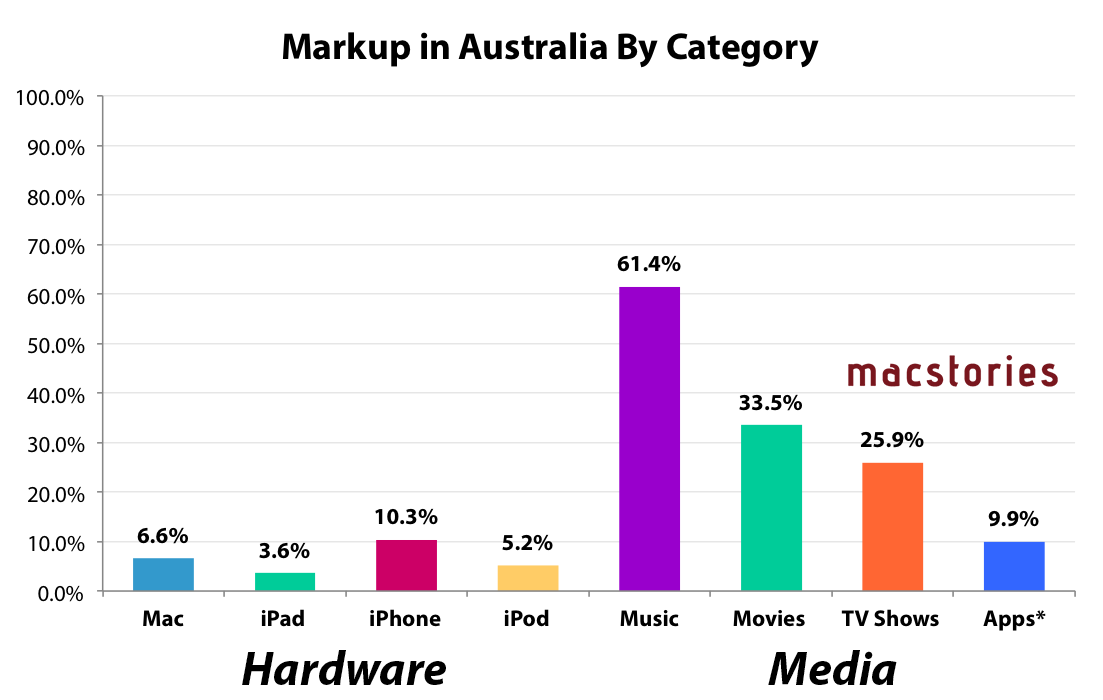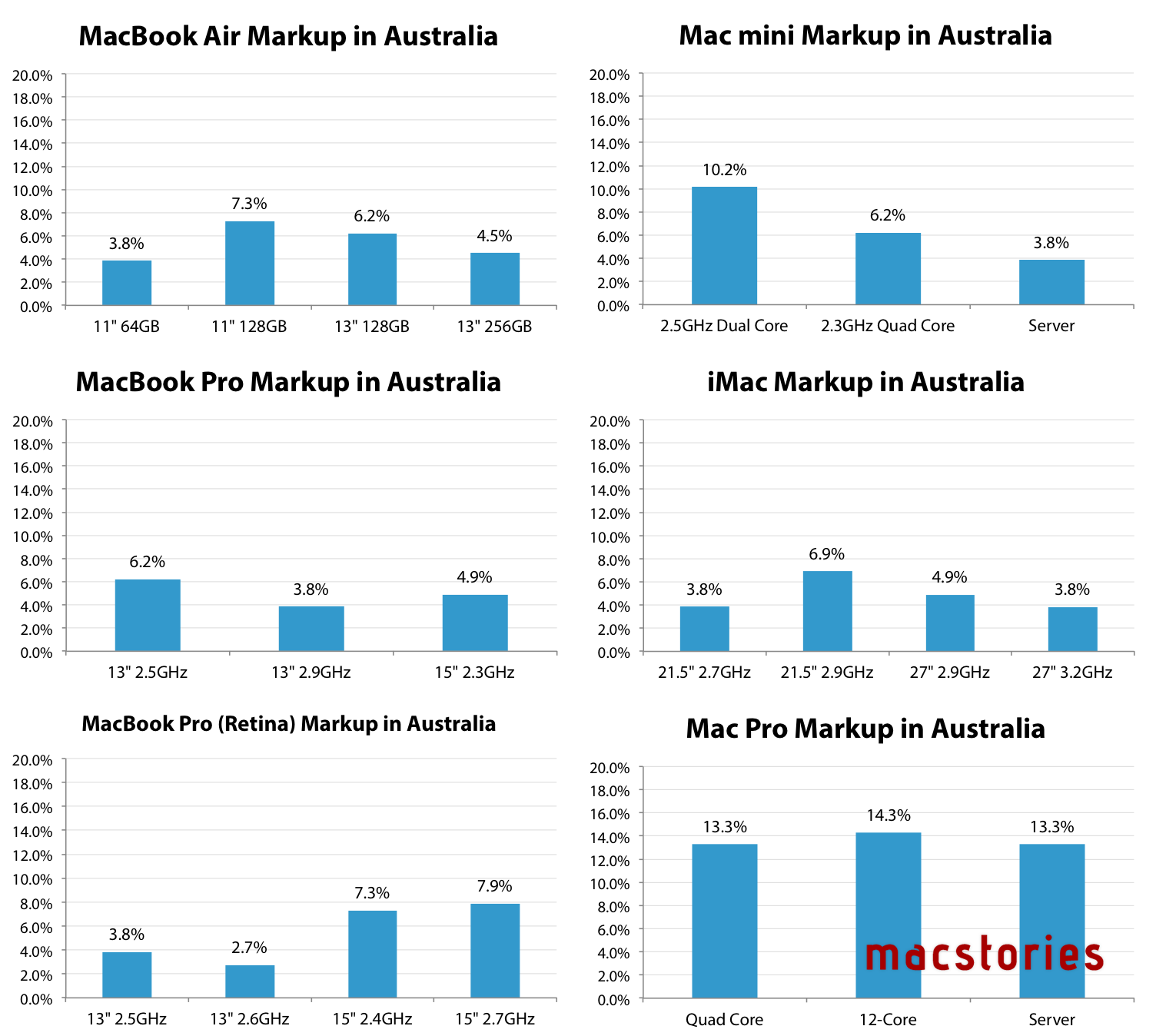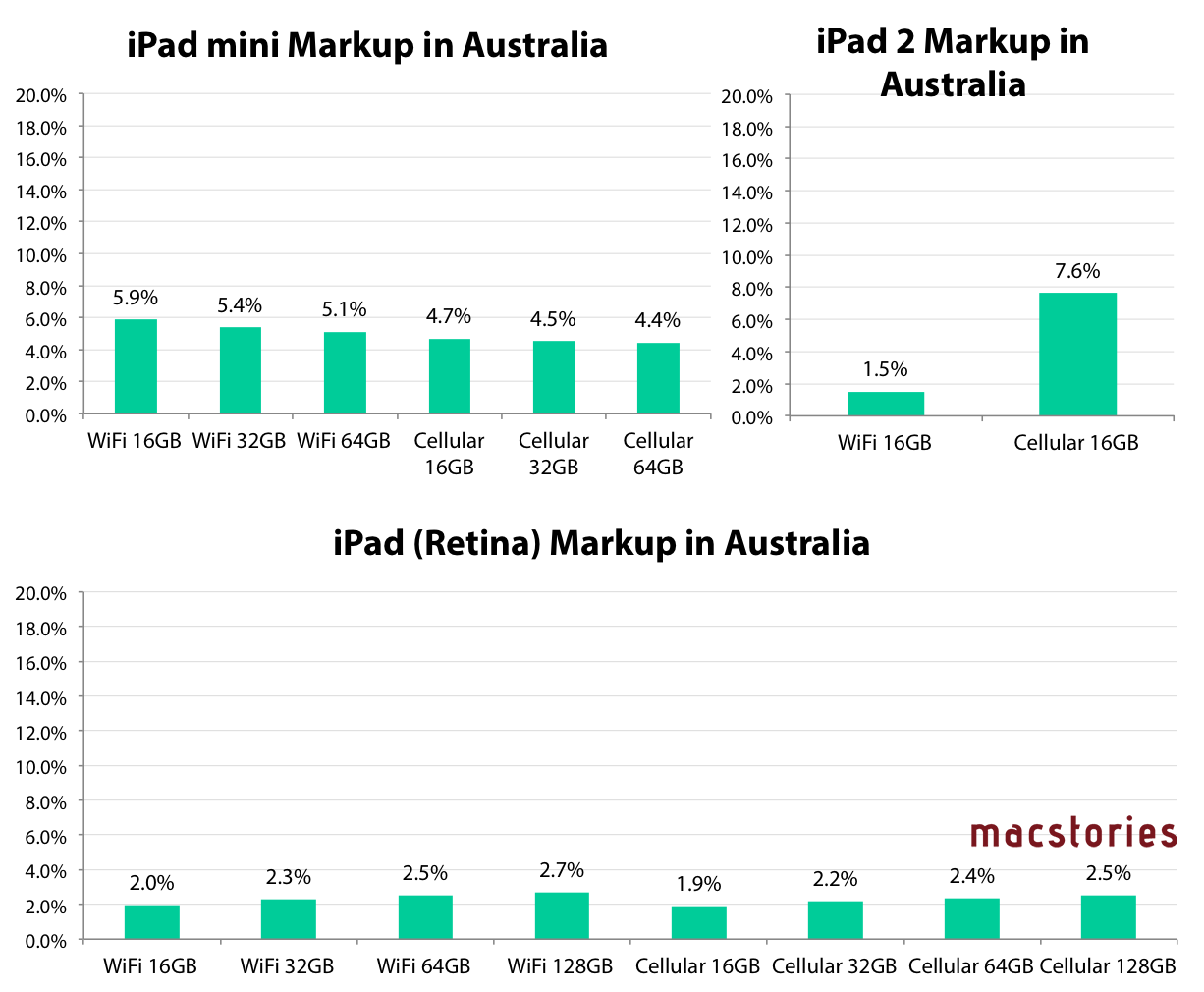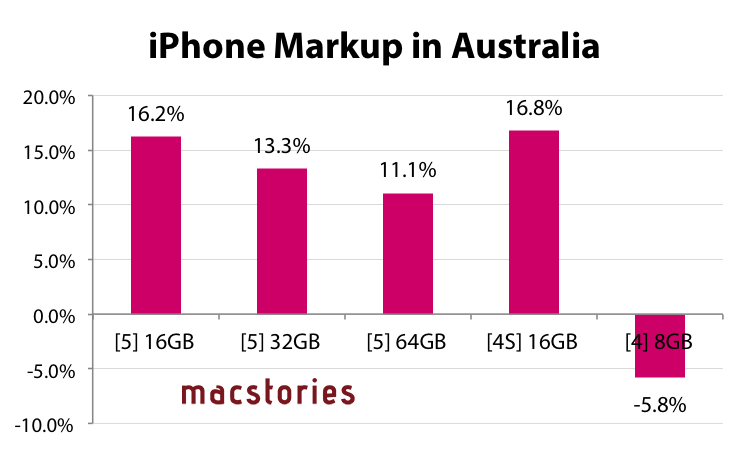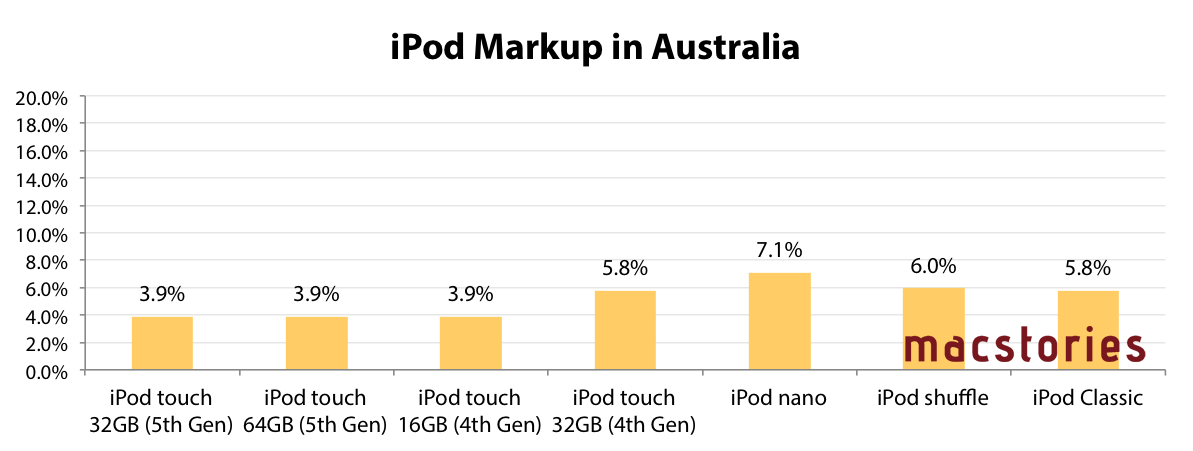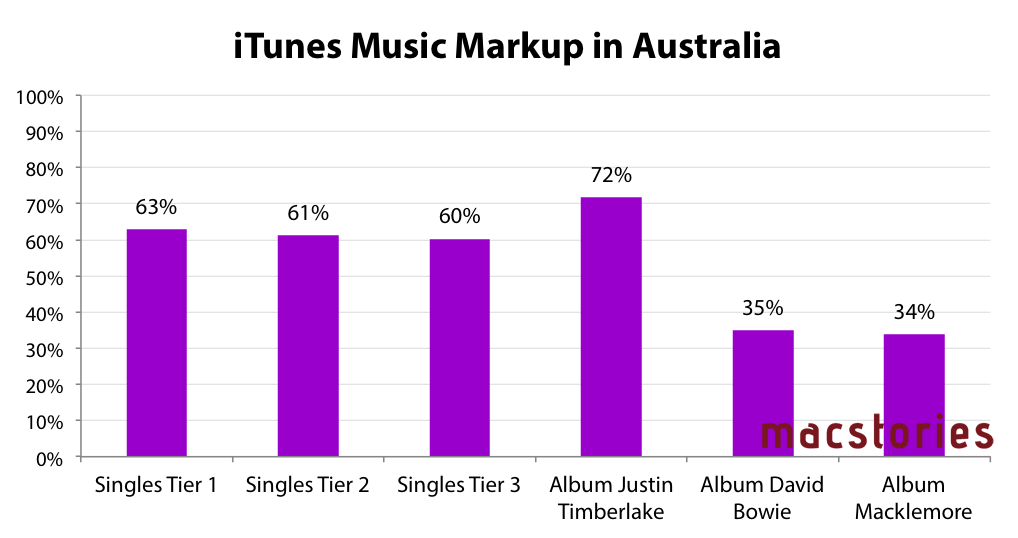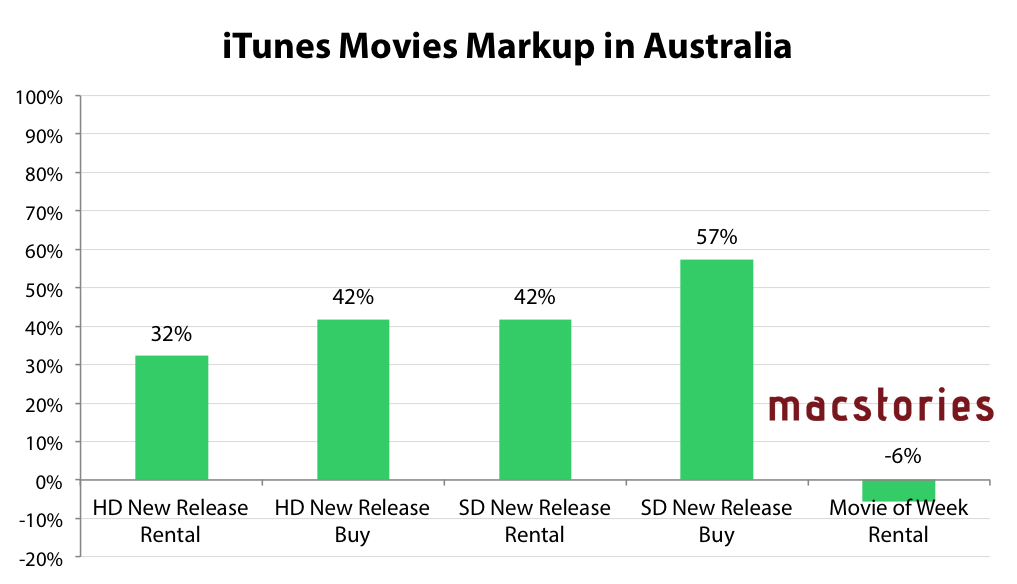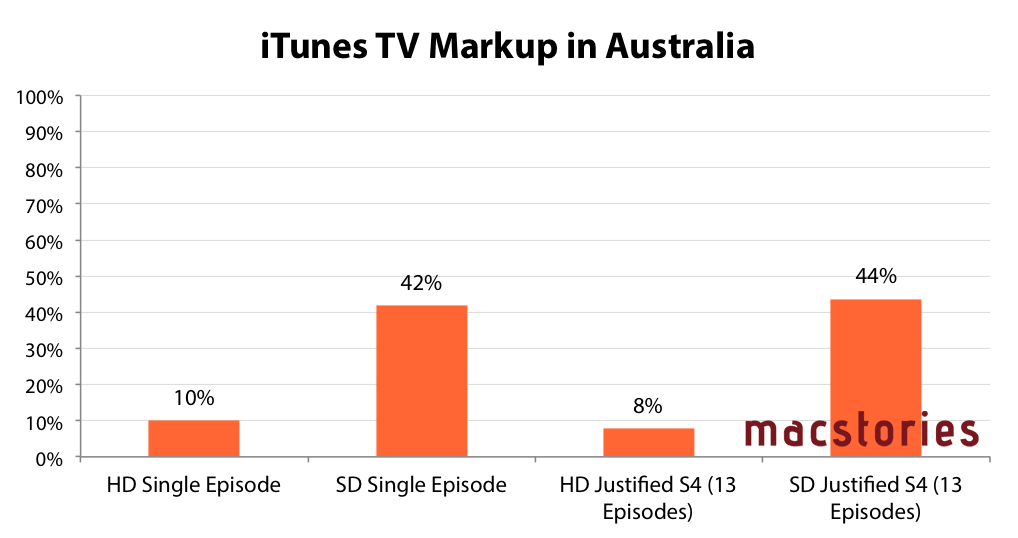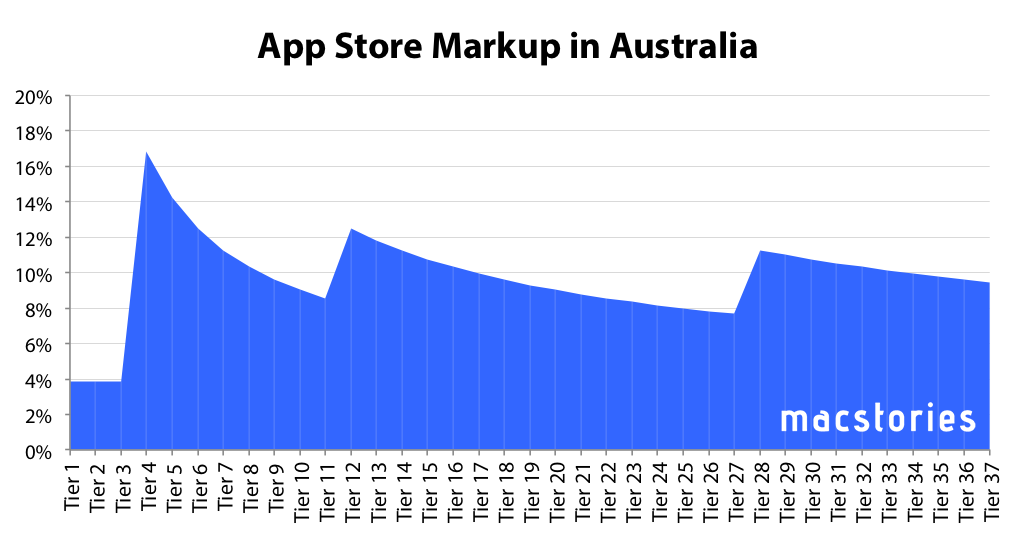On Friday, Apple (along with Microsoft and Adobe) will front the Federal Australian Parliament’s inquiry into IT Pricing. You may recall that after failing to voluntarily appear, the committee in February of this year summonsed the three, effectively forcing them to appear. Given Apple’s appearance, I wanted to take a closer look to see what Apple actually charges for their products (both hardware and media from their iTunes and App Stores) and see how it compares to the US.
Methodology
Doing this kind of analysis can be fairly contentious given there are a few ways to do it, various assumptions you have to make, and different ways of presenting the information. To be clear, here is how I have constructed the data presented in the graphs in this article.
- I collected from Apple’s website, the Australian and US prices of all their key products and main models (but not built-to-order models).
- GST is removed from Australian price: The Australian price includes a 10% GST (goods and services tax), so I removed that from the Australian price because US prices do not include a sales tax, that is added at checkout based on which US state the customer is from (sales taxes varies across US states).
- Now that both prices don’t include sales taxes, I convert the Australian price from Australian dollars (AUD) to US dollars (USD). I use a 3 month average of the exchange rate. The 3 month average smoothes out any temporary peaks or troughs in the exchange rate and gives Apple a fairly lengthy period of time to alter prices if there was a significant change in the exchange rate.
- This now gives me the price of the Australian good in USD and without GST, a figure that can now be compared with the US price. So I calculate the percentage markup of the Australian price based on the original US price.
- NOTE: Methodology for the Media calculations do vary a bit, read the notes I include with them.
- I encourage you to scrutinise my calculations by taking a look at the Excel document I created, linked below.
Download Data
- Hardware Markup Summary Sheet
- Media Markup Summary Sheet
- Full Excel Document (Do not republish without permission)
Hardware
General Notes:
- Mac prices generally have a fairly low markup, with nearly all less than 10% which I think is acceptable. Mac Pro prices have a much larger markup which may be due to the fact it has been a while since the last update.
- iPad prices have even less of a markup, hovering around 4-5% for the iPad mini and a pretty incredible 2-3% for the iPad (Retina).
- iPhone prices have a more considerable markup, getting close to 20% for some. Curiously, the iPhone 4 is actually cheaper in Australia though. (Note that these are prices for the unlocked iPhone models - not the on-contract price)
- iPod prices are on the whole pretty respectable, between a 3 and 7% markup.
Media
Music Notes:
- Apple offers three pricing tiers when selling individual songs, in the US they are $0.69, $0.99, and $1.29. In Australia they are $1.19, $1.69, and $2.19.
- Album prices aren’t standardised (there is a large range of pricing tiers), so I chose three recent albums to compare.
- There is clearly a huge markup on Australian prices, and even for those last two albums, the markup is still 35% and 34% - higher markup than any of the hardware.
Movies Notes:
- Because there doesn’t seem to be a clear matching of price tiers between the US and Australia, I had to err on the side of caution and where I was unsure of which was the correct figure, I used the one that was was favourable to Apple (i.e. whether 4.99 or 5.99 is the US HD rental price for new releases).
- But even with erring on the side favourable to Apple, I still got figures above 30% and even close to 60%. The one exception is the Movie of the Week rental which, when priced at $0.99 in both countries, becomes cheaper in Australia (because of the removal of GST)
- Like Music, TV shows have standard prices for individual episodes, but vary by TV show season.
- HD episodes and HD Season Passes contain relatively small markups, but SD is sold at a considerable markup in Australia.
- NOTE: GST is not removed from these prices. I decided to leave it in this calculation for two reasons. Firstly, it is the developers that bear the burden of paying the 10% GST (ie. it comes out of their 70% of revenues). Secondly, developers cannot price discriminate across countries, so if their app is on Tier 2 ($1.99), then it is on Tier 2 in every country. So developers cannot offset the tax by selling the app for a higher price in Australia.
- The graph has that weird shape because Apple makes all the Australian prices end in a neat 99 cents or 49 cents, which look good in the App Store.
- The average price markup clearly varies based on how many tiers you include, but the first 20 tiers average out to 9.9%.
The Markup on Media Adds Up
It’s pretty evident that the markup on media for Australian consumers is quite significant. To demonstrate the extent of the markup, I created a scenario where a US and Australian consumer purchase the same content from their respective stores and compare the difference. All up, I created the following selection of content which adds up to $152.11 of content from the US store with a mix of movies, music, TV shows and apps. An Australian purchasing the same content would have to spend $196.77 - a markup of $44.66.
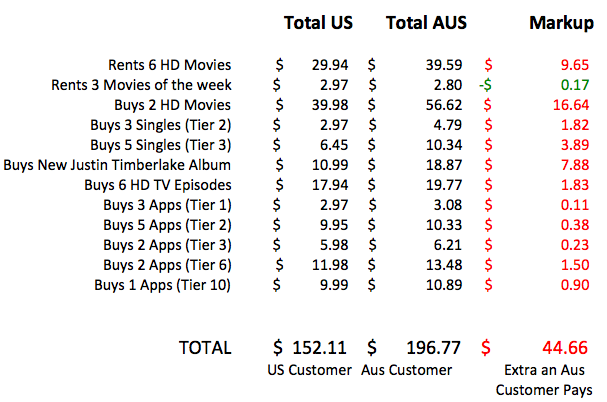 Conclusion
Conclusion
In the past, Australians have complained about the prices of Apple hardware compared to US prices, but that is no longer much of an issue. On the whole, Apple hardware in Australia has a fairly low markup that in my opinion is now acceptable - though the iPhone 5 is an exception to this, and should be lower. The real issue here is the markup on media - and specifically, iTunes. Music prices are just untenable where they are now, whilst movies and TV shows could also use significant reduction in the Australian markup.
So with all that said, here are some questions I hope will be put to Apple Australia’s leadership at tomorrow’s committee hearing:
- What are the approximate revenues of the Australian iTunes and App Stores? If it is substantial, as one would expect, why are prices marked up so significantly for Australians?
- How can the markup on media (i.e., completely digital content) be so significantly more than the Australian markup on Apple hardware which would presumably involve many more country-specific issues (shipping/support/recycling/etc) that might warrant a higher Australian price?
- Why are music prices so much higher (~60%) in Australia, compared to the US? If it is because of the music labels, why haven’t you done more to pressure them to lower prices?
- Why do movies (both rentals and buying) cost upwards of 30% more in Australia?
- Why is the markup on SD movies and TV shows so high?
- The markup on most of Apple’s hardware products is well under 10%, but then on the iPhone 5 it soars up close to 20%, why is that?
- How do you deal with foreign exchange risk?
- Why don’t you more frequently update Australian pricing to keep up with foreign exchange rates?


